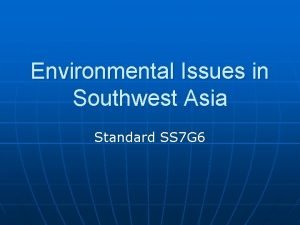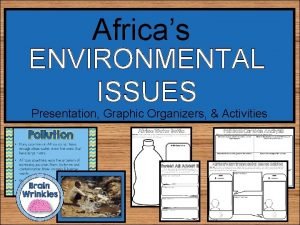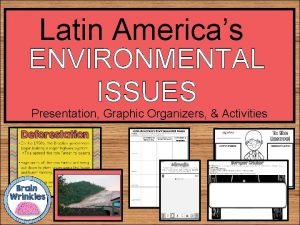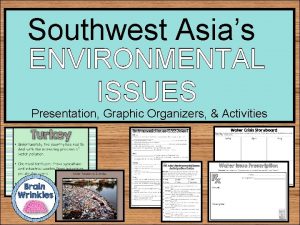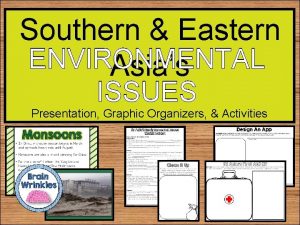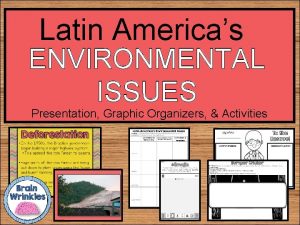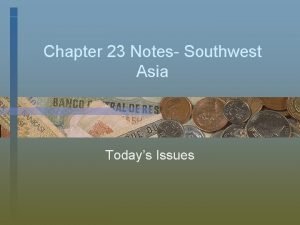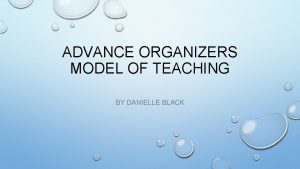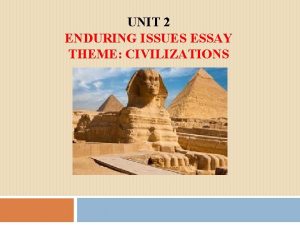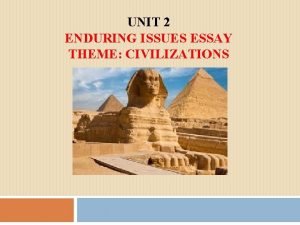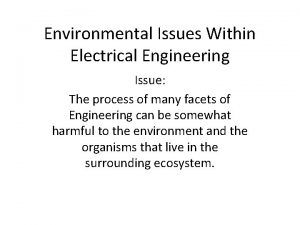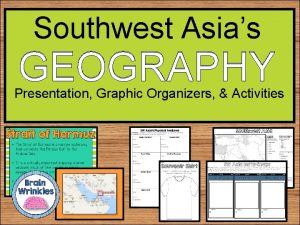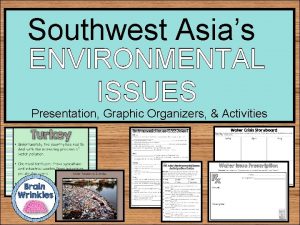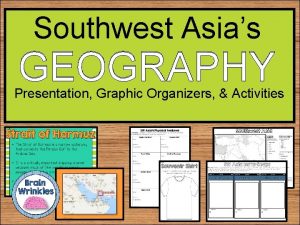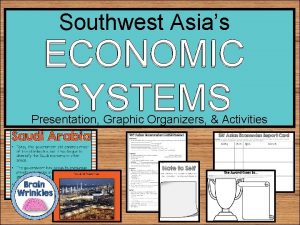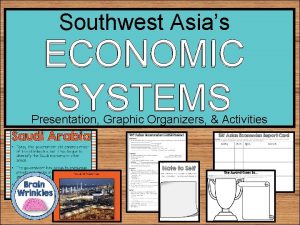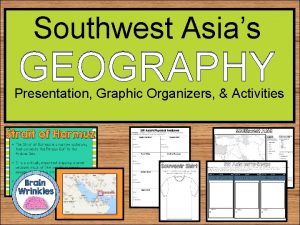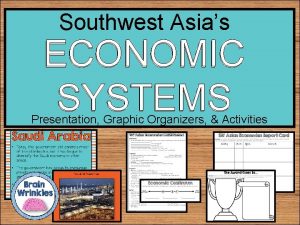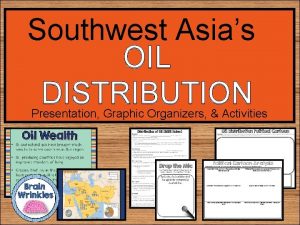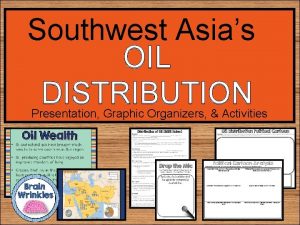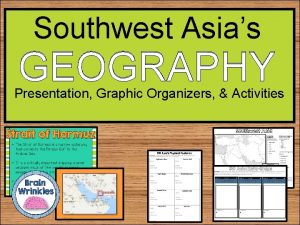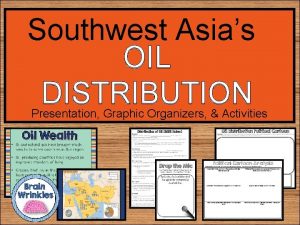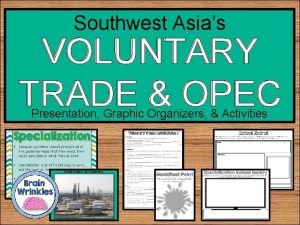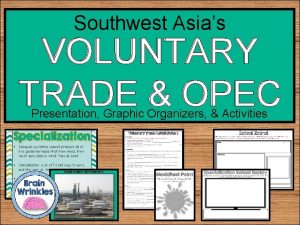Southwest Asias ENVIRONMENTAL ISSUES Presentation Graphic Organizers Activities


































- Slides: 34

Southwest Asia’s ENVIRONMENTAL ISSUES Presentation, Graphic Organizers, & Activities

STANDARDS: SS 7 G 6 The student will discuss environmental issues across Southwest Asia (Middle East). a. Explain how water pollution and the unequal distribution of water impacts irrigation and drinking water. © Brain Wrinkles

Southwest Asia’s Environmental Issues Water Pollution & Unequal Distribution © Brain Wrinkles

Pollution • Many countries in Southwest Asia are experiencing the increasing problem of water pollution. • Per-capita availability of safe drinking water here is the worst of any region in the world. • Contaminated water sources have greatly reduced the amount of clean water available for drinking. © Brain Wrinkles

Causes • Southwest Asia’s biggest pollution problems come from human sewage, agricultural runoff, and industrial waste. • Rapid growth of industry in cities and towns has caused garbage and sewage to build up in rivers and streams. • Towns without proper sewer systems dump untreated human waste directly into rivers. • Pesticides used in farming are washed into rivers or seep into groundwater. © Brain Wrinkles

Tigris River Pollution © Brain Wrinkles

Water? • Water availability is also a major concern in Southwest Asia. • Less than 1% of the world’s fresh water is available to the area’s inhabitants (5% of the world’s population). © Brain Wrinkles

© Brain Wrinkles

Scarcity • Water is a precious resource and there is simply not enough available to meet the population’s needs. • Middle Eastern countries are constantly in conflict over these water problems. • Let’s take a look at how water is distributed in several of these countries. © Brain Wrinkles

© Brain Wrinkles

Turkey • Turkey has a “water advantage” over other Middle Eastern countries because the Tigris and Euphrates rivers form here. • Turkey has developed the Southeastern Anatolia Project, which consists of 22 dams and 19 hydroelectric plants along the Euphrates River. • This project has greatly improved the standard of living for Turkey’s citizens. © Brain Wrinkles

Turkey’s Ataturk Dam © Brain Wrinkles

Turkey • Unfortunately, the country has had to deal with the increasing problem of water pollution. • Chemical fertilizers from agriculture and industrial wastes from industries pollute the rivers. • Pollution also comes from oil spills in the Black Sea. © Brain Wrinkles

Water Pollution in Istanbul © Brain Wrinkles

Syria • The dams that Turkey built along the Euphrates have greatly reduced the amount of water reaching Syria (40% less). • Syria already suffers from food shortages, and irrigating new land is extremely difficult with the diminished water supply from the Euphrates. © Brain Wrinkles

© Brain Wrinkles

Syria • In order to keep some water in the country, Syria has also built dams along the river. • This has reduced the river’s flow into Iraq, thus causing more conflict. © Brain Wrinkles

Lake Assad – Syria’s largest reservoir was created in 1974 © Brain Wrinkles

Iraq • The dams that Turkey & Syria built along the Euphrates have also greatly reduced the amount of water reaching Iraq (80% less). • This has negatively impacted the country’s food supply. • Wheat and rice production has decreased dramatically, and many farmers are now without jobs. © Brain Wrinkles

© Brain Wrinkles

Iraq • Iraq also faces water pollution problems as a result of industry and petroleum drilling equipment. • Also, three decades of warfare have caused damage to Iraq’s water treatment plants. © Brain Wrinkles

The Glory Canal (built by Suddam Hussein in 1993) was a disastrous project that diverted natural water flow from the country’s marshes and converted wetlands into desert. © Brain Wrinkles

Israel • Since its creation in 1948, Israel has developed new technology and advanced farming techniques that have turned the once-barren desert land into farmland. • Because rainfall is down, Israel has to rely on drawing water from its aquifers (underground layer of rock and sand that contains water). • Unfortunately, the aquifers are in jeopardy because more water is taken out than is replenished by rain. © Brain Wrinkles

National Water Carrier of Israel – A pipeline that transfers water from the Sea of Galilee to the highly populated center and arid south. © Brain Wrinkles

© Brain Wrinkles

Israel • Israel has been involved in many conflicts over water rights to the Jordan River with Syria, Jordan, and Palestine. © Brain Wrinkles

Jordan • Jordan is one of the ten most water scarce countries in the world. • Jordan cannot meet the basic needs of its people and has to ration the water supply. • Citizens can only get water two days a week. • The country’s major surface water sources are shared with Israel and Syria, who leave only a small amount for Jordan. © Brain Wrinkles

© Brain Wrinkles

Mujib Dam, Jordan – Desalinates brackish water from the Dead Sea © Brain Wrinkles

Jordan • Israel has built pipelines that redirect the river’s water away from Jordan and into its own lands. • Jordan & Israel have been involved in military battles over water rights. © Brain Wrinkles

Saudi Arabia • Saudi Arabia has a desert climate and has struggled to meet the water needs of its growing population. • Water is scarce in the country, and what little water that is available is of poor quality because of salt water intrusion. © Brain Wrinkles

© Brain Wrinkles

Saudi Arabia • The country has built a number of desalination plants that provide most of the country’s drinking water. • Desalination is the process of taking salt out of seawater and using it for drinking water. © Brain Wrinkles

World’s Largest Desalination Plant – Jubail Industrial City, Saudi Arabia © Brain Wrinkles
 Yellow sea and east china sea
Yellow sea and east china sea Environmental issues in southwest asia
Environmental issues in southwest asia Tea blank graphic organizers
Tea blank graphic organizers Blank graphic organizers for math staar
Blank graphic organizers for math staar Tea supplemental aids
Tea supplemental aids Organizers
Organizers Universal accommodations for mcas
Universal accommodations for mcas Generalization and example pattern organizer example
Generalization and example pattern organizer example Blank graphic organizers for staar
Blank graphic organizers for staar Marzano graphic organizers
Marzano graphic organizers Mcas graphic organizers
Mcas graphic organizers Environmental issues graphic organizer
Environmental issues graphic organizer Brain wrinkles southwest asia
Brain wrinkles southwest asia Environmental issues graphic organizer
Environmental issues graphic organizer Environmental issues cloze notes 1
Environmental issues cloze notes 1 Environmental issues cloze notes 1
Environmental issues cloze notes 1 Environmental issues graphic organizer
Environmental issues graphic organizer Environmental issues graphic organizer
Environmental issues graphic organizer Chapter 23 today's issues southwest asia
Chapter 23 today's issues southwest asia Graphic weight meaning
Graphic weight meaning Ghost graphic story graphic and wayfinding
Ghost graphic story graphic and wayfinding Expository advance organizer
Expository advance organizer Model advance organizer
Model advance organizer Expository advance organizers examples
Expository advance organizers examples Dear organizers
Dear organizers Discourse analysis and vocabulary
Discourse analysis and vocabulary Cues questions and advance organizers
Cues questions and advance organizers Cues questions and advance organizers
Cues questions and advance organizers Cues questions and advance organizers
Cues questions and advance organizers Enduring issues graphic organizer
Enduring issues graphic organizer Enduring issues essay graphic organizer
Enduring issues essay graphic organizer Earth system graphic organizer
Earth system graphic organizer Explain how dishes on a menu address environmental issues
Explain how dishes on a menu address environmental issues Environmental and resource efficiency issues
Environmental and resource efficiency issues Electrical engineering environmental issues
Electrical engineering environmental issues

